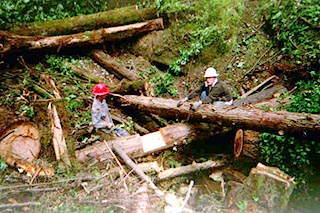|
Subscribe / Renew |
|
|
Contact Us |
|
| ► Subscribe to our Free Weekly Newsletter | |
| home | Welcome, sign in or click here to subscribe. | login |
Protecting the Environment '99
|
|
Finding a `natural' solution to erosion
By RON BARD The Weowna Park renovation completed late last year used a natural systems approach to reduce erosion, by armoring the creek and dissipating energy. The project illustrates how "hard" engineering can be combined with natural improvements, and how understanding natural processes can help find solutions that work with nature. Weowna Park is a heavily forested, 90-acre, undeveloped urban park. A watercourse (unofficially named Phantom Creek) in the park had gullies up to 50 feet deep, and waterfalls up to 20 feet high. King County, the original owner, had offered to turn the park over to the city of Bellevue.
Phantom Creek is not a natural creek. Around the turn of the century, farmers dug the channel to create more tillable farmland by lowering the elevation of Phantom Lake. Within the park is a small natural depression that previously had drained only a few acres, but now drains over 500 acres. Phantom Creek had been relatively stable until development within the drainage basin caused flows to increase. The eroded channel was rebuilt, and a meander was created within the existing banks to make the stream appear natural and slow its flow. The two waterfalls were stabilized, and log and rock check-dams were used to further stabilize the channel. Log x-weirs, filled in with woody debris, boulders and rocks, were designed to channel water to the center of the stream bed, and the protruding ends of the logs were angled up to cause the water to pool and drain out through the "v." Natural woody debris dams were added throughout the length of the channel, and large boulders were placed to absorb energy. The finished product emulates a natural stream that has been stabilized over time by natural processes. A sedimentation basin was designed to allow silt to settle out of the water before it enters Lake Sammamish, to reduce the flow of eroded materials and associated phosphorus loading.
An engineered "waterfall" was constructed by installing a shotcrete/soil-nail wall. Seventy soil nails, driven 30 feet into the eroding bank, and two layers of wire mesh, provide structural support to the 12-inch-thick shotcrete wall. Drainage geotextile fabric between the soil and the concrete controls any water seepage behind the wall. Shotcrete was also used to line the streambed leading up to the waterfall, and a shotcrete dam submerged at the upstream end to deter water from flowing beneath the shotcrete shell and undermining the wall structure. The concrete was colored to match Weowna's soil, and rocks were hand-placed in the wet concrete to match the soil strata, and make it indistinguishable from the surrounding soil. Our firm believes this was the first use of a shotcrete wall in a creek restoration project. This and other elements of the project illustrate how "hard" engineering can be combined with a natural systems approach to tailor solutions to meet the project needs - solutions that work with nature, not against it. Because the park is undeveloped, site access is difficult. This problem was solved by using logging equipment and hand labor to place materials. A swing yarder and aerial cables were used to transport rocks, boulders and logs to construct x-weirs in the ravine, from above the first channel drop to the canyon area below. These methods minimized disturbance to the creek and its surroundings.
Residents and environmental groups were outspoken about their concerns that the park be an aesthetic and recreational asset for the neighborhood. With this in mind, Sverdrup, the city of Bellevue, and King County planned and carried out an extensive public involvement program to get residents' input for design, and to generate support for the project. Public involvement was critical and rewarding. Building on the city of Bellevue Parks Department's history of successfully working with the community, the Sverdrup design team engaged the public in discussions, involved them in the design process and incorporated elements which were important to the public, while controlling costs. Sverdrup Civil, Inc. received the Consulting Engineers Council of Washington Honor Award for the Weowna Park Creek restoration project design. Sverdrup Civil's Northwest Region is headquartered in Bellevue. Ron Bard, P.E., was Sverdrup's project manager. The Watershed Co., Golder Associates, Jones & Stokes, Jones & Jones were subconsultants involved in the project design.
Ron Bard is manager of civil design for the Bellevue office Sverdrup Civil, an engineering consulting firm.
 djc home | top | special issues index
|



